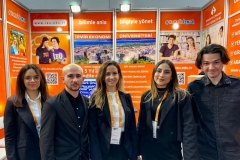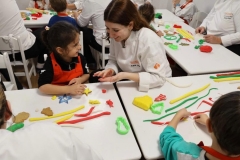
SCHOOL OF APPLIED MANAGEMENT SCIENCES
Gastronomy and Culinary Arts Program
CLM 488 | Course Introduction and Application Information
| Course Name |
Trends in Culinary History
|
|
Code
|
Semester
|
Theory
(hour/week) |
Application/Lab
(hour/week) |
Local Credits
|
ECTS
|
|
CLM 488
|
Fall/Spring
|
3
|
0
|
3
|
5
|
| Prerequisites |
None
|
|||||
| Course Language |
English
|
|||||
| Course Type |
Service Course
|
|||||
| Course Level |
First Cycle
|
|||||
| Mode of Delivery | - | |||||
| Teaching Methods and Techniques of the Course | - | |||||
| Course Coordinator | - | |||||
| Course Lecturer(s) | ||||||
| Assistant(s) | - | |||||
| Course Objectives | This course aims to provide students knowledge and understanding about food and apply that knowledge to their academic and professional lives. This course will enhance students vision in food sector and will give the encourage to create future trends. |
| Learning Outcomes |
The students who succeeded in this course;
|
| Course Description | Students are expected to research and develop new ideas for future trends in food sector. |
|
|
Core Courses | |
| Major Area Courses | ||
| Supportive Courses |
X
|
|
| Media and Management Skills Courses | ||
| Transferable Skill Courses |
WEEKLY SUBJECTS AND RELATED PREPARATION STUDIES
| Week | Subjects | Related Preparation |
| 1 | İntroduction | |
| 2 | Why study food? | Warren Belasco, “Introduction”, Food: The Key Concepts, New York: Berg, 2008, s. 1-13. |
| 3 | Back to Basics: Hunters, gatherers, and farmers | Brian Hayden, “Hunting and Gathering”, Encyclopedia of Food and Culture içinde, Solomon H. Katz (ed.), vol. 2, NY: Thomson, 2003, s. 222-226. |
| 4 | Traditional food cultures | Jeffrey M. Pilcher, Food in World History, “Chapter 1: The First World Cuisine”, NY, London: Routledge, 2006, s. 8-16. |
| 5 | Consequences of contact: trade, colonialism, and globalization. | Jeffrey M. Pilcher, Food in World History, “Chapter 2: The Columbian Exchange”, NY. London: Routledge, 2006, s. 19-26. |
| 6 | Sugar and power | Jeffrey M. Pilcher, Food in World History, “Chapter 3: Sugar, Spice, and Blood”, NY. London: Routledge, 2006, s. 27-33. |
| 7 | Midterm Exam | |
| 8 | Aesthetics and connoisseurship | Jean-Louis Flandrin, “Dietary Choices and Culinary Technique, 1500-1800” Food. A Culinary History from Antiquity to the Present içinde, Jean-Louis Flandrin ve Massimo Montanari (eds.), NY: Columbia University Press, 1999, s. 403-417. |
| 9 | Emergence of restaurants | Jean-Robert Pitte, “The Rise of Restaurant”, Food. A Culinary History from Antiquity to the Present içinde, Jean-Louis Flandrin ve Massimo Montanari (eds.), NY: Columbia University Press, 1999, s. 471-480. |
| 10 | Famine and the modern history of hunger | Cormac O Grada, The Great Irish Famine, “Chapter 2: The Great Hunger”, Macmillan, 1989, s. 39-64. |
| 11 | Food, nation, and identity | Alison K. Smith, “National Cuisines”, The Oxford Handbook of Food History içinde, Jeffrey M. Pilcher (ed.), Oxford University Press, 2012, p. 444-460. |
| 12 | Globalization of food industry and fast food | Jeffrey M. Pilcher, Food in World History, “Chapter 11 ve 12: The Green Revolution” ve “McDonaldization and its discontents”, NY. London: Routledge, 2006, p.100-112. |
| 13 | Organic and slow food alternatives | Michael Pollan, The Omnivore’s Dilemma. A Natural History of Four Meals, “Chapter 8: All Flesh is Grass”, London: Penguin, 2006, p. 123-133. |
| 14 | Food science, cooking, molecular gastronomy | Nicholas Kurti, Herve This-Benckhard, “Chemistry and Physics in the Kitchen”, Scientific American, 270 (4), s. 66-71. |
| 15 | Review of the semester | |
| 16 | Final Exam |
| Course Notes/Textbooks | Warren Belasco, Food: the key concepts, New York: Berg, 2008. ISBN: 9781845206727 Jeffrey M. Pilcher, Food in World History, NY, London: Routledge, 2006, ISBN 0-415-31146-2 |
| Suggested Readings/Materials | MINTZ S. Sweetness and Power: The Place of Sugar in Modern History, Penguin Books. 1986, ISBN 978-0140092332 Solomon H. Katz (ed), Encyclopedia of Food and Culture, three volumes, NY: Thomson, 2003, ISBN 978-0684805689 Jean-Louis Flandrin ve Massimo Montanari (eds.), Food. A Culinary History from Antiquity to the Present, NY: Columbia University Press, 1999, ISBN 9780231111546 Michael Pollan, The Omnivore’s Dilemma. A Natural History of Four Meals, London: Penguin, 2006, ISBN 1594200823 p. 123-133 |
EVALUATION SYSTEM
| Semester Activities | Number | Weigthing |
| Participation |
1
|
10
|
| Laboratory / Application | ||
| Field Work | ||
| Quizzes / Studio Critiques | ||
| Portfolio | ||
| Homework / Assignments | ||
| Presentation / Jury | ||
| Project |
1
|
25
|
| Seminar / Workshop | ||
| Oral Exams | ||
| Midterm |
1
|
25
|
| Final Exam |
1
|
40
|
| Total |
| Weighting of Semester Activities on the Final Grade |
3
|
60
|
| Weighting of End-of-Semester Activities on the Final Grade |
1
|
40
|
| Total |
ECTS / WORKLOAD TABLE
| Semester Activities | Number | Duration (Hours) | Workload |
|---|---|---|---|
| Theoretical Course Hours (Including exam week: 16 x total hours) |
16
|
3
|
48
|
| Laboratory / Application Hours (Including exam week: '.16.' x total hours) |
16
|
0
|
|
| Study Hours Out of Class |
16
|
2
|
32
|
| Field Work |
0
|
||
| Quizzes / Studio Critiques |
0
|
||
| Portfolio |
0
|
||
| Homework / Assignments |
4
|
0
|
|
| Presentation / Jury |
0
|
||
| Project |
1
|
30
|
30
|
| Seminar / Workshop |
0
|
||
| Oral Exam |
0
|
||
| Midterms |
1
|
20
|
20
|
| Final Exam |
1
|
20
|
20
|
| Total |
150
|
COURSE LEARNING OUTCOMES AND PROGRAM QUALIFICATIONS RELATIONSHIP
|
#
|
Program Competencies/Outcomes |
* Contribution Level
|
||||
|
1
|
2
|
3
|
4
|
5
|
||
| 1 | Successfully applies theoretical and practical knowledge and skills in Gastronomy and Culinary Arts |
X | ||||
| 2 | Carries best practices in terms of work and food security, safety and hygiene in food production |
|||||
| 3 | Appreciates, evaluates and makes decisions regarding to visual, textual and nutritional data with respect to food production and presentation |
|||||
| 4 | Recognizes and evaluates the impact of gastronomy on culture and society |
X | ||||
| 5 | Assumes responsibility for solving complex problems that may occur in the field of Gastronomy and Culinary Arts, both individually and as a team member |
|||||
| 6 | Evaluates the knowledge and skills acquired in the field of Gastronomy and Culinary Arts with a critical approach and effectively communicate their ideas and suggestions for solutions in written and oral form. |
|||||
| 7 | Possesses necessary knowledge and skills in relevant fields such as gastronomy, design, law and management and effectively apply them to the practice of Culinary Arts |
X | ||||
| 8 | Uses the technological tools related to Gastronomy and Culinary Arts effectively |
|||||
| 9 | Updates and improve the knowledge, skills and competencies related to Gastronomy and Culinary Arts with lifelong learning awareness and sustainability with an ethical approach |
X | ||||
| 10 | Collects data in the areas of Gastronomy and Culinary Arts and communicate with colleagues in a foreign language. (European Language Portfolio Global Scale”, Level B1) |
X | ||||
| 11 | Speaks a second foreign at a medium level of fluency efficiently |
|||||
| 12 | Relates the knowledge gained through the history of humanity to the field of expertise |
X | ||||
*1 Lowest, 2 Low, 3 Average, 4 High, 5 Highest
NEWS |ALL NEWS
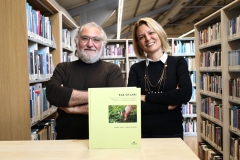
Award-Winning Book Receives Great Interest
The book ‘Ege Otları (Aegean Herbs)’ authored by Asst. Prof. Dr. Betül Öztürk from Department of Gastronomy and Culinary Arts, Izmir University
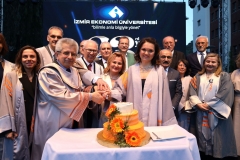
Appointment ceremony for 104 academics
A special ceremony was held at Izmir University of Economics (IUE) for the 104 academics appointed to professorship, associate professorship, and assistant

Aegean flavors from the chefs of the future
Izmir University of Economics (IUE) Department of Gastronomy and Culinary Arts left its mark on the 6th Izmir GastroFest, organized this year with
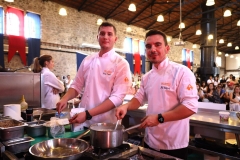
They added flavor to GURMEFEST
GURMEFEST, one of the biggest food, drink and entertainment festivals of Izmir, was ‘flavored’ with the dishes prepared and presented by the
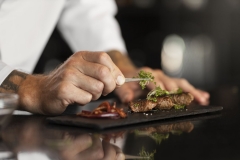
“Izmir and Bodrum will class up”
The MICHELIN Guide, one of the most prestigious restaurant rating systems in the world, has added Izmir and Bodrum to its Turkish
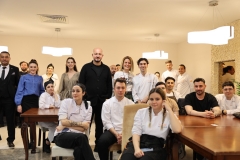
IUE graduates will prepare the flavors unique to Turkish cuisine
Bilsev Group, who is preparing to expand to Dubai this year with its Ferdi Baba, Fabrice Restaurant and Baba Pizza brands, will



